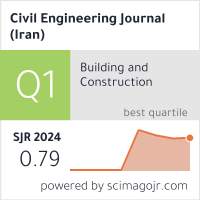Effect of the Mortar Volume Ratio on the Mechanical Behavior of Class CI Fly Ash-Based Geopolymer Concrete
Downloads
Doi:10.28991/CEJ-2022-08-09-012
Full Text:PDF
Downloads
[2] Wattimena, O. K., Antoni, & Hardjito, D. (2017). A review on the effect of fly ash characteristics and their variations on the synthesis of fly ash based geopolymer. AIP Conference Proceedings. doi:10.1063/1.5003524.
[3] Xu, H., & Van Deventer, J. S. J. (2000). The geopolymerisation of alumino-silicate minerals. International Journal of Mineral Processing, 59(3), 247–266. doi:10.1016/S0301-7516(99)00074-5.
[4] Winnefeld, F., Leemann, A., Lucuk, M., Svoboda, P., & Neuroth, M. (2010). Assessment of phase formation in alkali activated low and high calcium fly ashes in building materials. Construction and Building Materials, 24(6), 1086–1093. doi:10.1016/j.conbuildmat.2009.11.007.
[5] Palomo, A., Blanco-Varela, M. T., Granizo, M. L., Puertas, F., Vazquez, T., & Grutzeck, M. W. (1999). Chemical stability of cementitious materials based on metakaolin. Cement and Concrete Research, 29(7), 997–1004. doi:10.1016/S0008-8846(99)00074-5.
[6] Risdanareni, P., Puspitasari, P., & Januarti Jaya, E. (2017). Chemical and Physical Characterization of Fly Ash as Geopolymer Material. MATEC Web of Conferences, 97, 01031. doi:10.1051/matecconf/20179701031.
[7] Ekaputri, J. J., Ulum, M. B., Triwulan, Bayuaji, R., Susanto, T. E., & Al Bakri Abdullah, M. M. (2015). A Comprehensive Characterization and Determination of Fly Ashes in Indonesia Using Different Methods. Applied Mechanics and Materials, 754–755, 320–325. doi:10.4028/www.scientific.net/amm.754-755.320.
[8] Chindaprasirt, P., Chareerat, T., Hatanaka, S., & Cao, T. (2011). High-Strength Geopolymer Using Fine High-Calcium Fly Ash. Journal of Materials in Civil Engineering, 23(3), 264–270. doi:10.1061/(asce)mt.1943-5533.0000161.
[9] Hadi, M. N. S., Zhang, H., & Parkinson, S. (2019). Optimum mix design of geopolymer pastes and concretes cured in ambient condition based on compressive strength, setting time and workability. Journal of Building Engineering, 23(November), 301–313. doi:10.1016/j.jobe.2019.02.006.
[10] Vijaya Prasad, B., Anand, N., Arumairaj, P. D., Sanath Kumar, M., Dhilip, T., & Srikanth, G. (2021). Studies on Mechanical properties of High Calcium Fly ash based sustainable Geopolymer concrete. Journal of Physics: Conference Series, 2070(1), 012184. doi:10.1088/1742-6596/2070/1/012184.
[11] Guo, X., Shi, H., & Dick, W. A. (2010). Compressive strength and microstructural characteristics of class C fly ash geopolymer. Cement and Concrete Composites, 32(2), 142–147. doi:10.1016/j.cemconcomp.2009.11.003.
[12] Chindaprasirt, P., De Silva, P., Sagoe-Crentsil, K., & Hanjitsuwan, S. (2012). Effect of SiO2 and Al2O3 on the setting and hardening of high calcium fly ash-based geopolymer systems. Journal of Materials Science, 47(12), 4876–4883. doi:10.1007/s10853-012-6353-y.
[13] Hanjitsuwan, S., Hunpratub, S., Thongbai, P., Maensiri, S., Sata, V., & Chindaprasirt, P. (2014). Effects of NaOH concentrations on physical and electrical properties of high calcium fly ash geopolymer paste. Cement and Concrete Composites, 45, 9–14. doi:10.1016/j.cemconcomp.2013.09.012.
[14] Ridzuan, A. R. M., Khairulniza, A. A., & Arshad, M. F. (2015). Effect of sodium silicate types on the high calcium geopolymer concrete. Materials Science Forum, 803, 185–193. doi:10.4028/www.scientific.net/MSF.803.185.
[15] Tennakoon, C., Sagoe-Crentsil, K., San Nicolas, R., & Sanjayan, J. G. (2015). Characteristics of Australian brown coal fly ash blended geopolymers. Construction and Building Materials, 101, 396–409. doi:10.1016/j.conbuildmat.2015.10.089.
[16] Dirgantara, R., Gunasekara, C., Law, D. W., & Molyneaux, T. K. (2017). Suitability of Brown Coal Fly Ash for Geopolymer Production. Journal of Materials in Civil Engineering, 29(12), 4017247. doi:10.1061/(asce)mt.1943-5533.0002093.
[17] Ramesh, V., & Srikanth, Dr. K. (2020). Mechanical Properties and Mix Design of Geopolymer concrete – A review. E3S Web of Conferences, 184, 01091. doi:10.1051/e3sconf/202018401091.
[18] Jindal, B. B. (2019). Investigations on the properties of geopolymer mortar and concrete with mineral admixtures: A review. Construction and Building Materials, 227, 116644. doi:10.1016/j.conbuildmat.2019.08.025.
[19] Ahmad Sofri, L., Mustafa Al Bakri Abdullah, M., Rosli Mohd Hasan, M., & Huang, Y. (2020). The Influence of Sodium Hydroxide Concentration on Physical Properties and Strength Development of High Calcium Fly Ash Based Geopolymer as Pavement Base Materials. IOP Conference Series: Materials Science and Engineering, 864(1), 012016. doi:10.1088/1757-899x/864/1/012016.
[20] Hassan, A., Arif, M., & Shariq, M. (2019). Use of geopolymer concrete for a cleaner and sustainable environment – A review of mechanical properties and microstructure. Journal of Cleaner Production, 223, 704–728. doi:10.1016/j.jclepro.2019.03.051.
[21] ASTM C143/C143M-12. (2015). Standard Test Method for Slump of Hydraulic-Cement Concrete. ASTM International, Pennsylvania, United States. doi:10.1520/C0143_C0143M-12.
[22] ASTM C618-12. (2017). Standard Specification for Coal Fly Ash and Raw or Calcined Natural Pozzolan for Use in Concrete. ASTM International, Pennsylvania, United States. doi:10.1520/C0618-12.
[23] ASTM C128-15. (2016). Standard Test Method for Density, Relative Density (Specific Gravity), and Absorption of Fine Aggregate. ASTM International, Pennsylvania, United States. doi:10.1520/C0128-15.
[24] ASTM C 136/C136M-19. (2020). Standard Test Method for Sieve Analysis of Fine and Coarse Aggregates. ASTM International, Pennsylvania, United States. doi:10.1520/C0136_C0136M-19.
[25] ASTM C33/C33M-18. (2018). Standard Specification for Concrete Aggregates. ASTM International, Pennsylvania, United States. doi:10.1520/C0033_C0033M.
[26] ASTM C127-15 (2016). Standard Test Method for Relative Density (Specific Gravity) and Absorption of Coarse Aggregate. ASTM International, Pennsylvania, United States. doi:10.1520/C0127-15.
[27] SNI 03-2834-2000. (2000). Tata cara pembuatan rencana campuran beton normal. Indonesian National Standard (SNI), Jakarta, Indonesia. (In Indonesian).
[28] Neville, A. M. (2012). Properties of concrete (5th Ed.). Pearson India, Noida, India.
[29] Gupta, N., Siddique, R., & Belarbi, R. (2021). Sustainable and greener self-compacting concrete incorporating industrial by-products: A review. Journal of Cleaner Production, 284, 124803. doi:10.1016/j.jclepro.2020.124803.
[30] Khalaf, A. A., & Kopecskó, K. (2020). Proposed simplified method of geopolymer concrete mix design. Concrete Structures, 21, 31–37. doi:10.32970/cs.2020.1.5.
[31] Li, N., Shi, C., Zhang, Z., Zhu, D., Hwang, H. J., Zhu, Y., & Sun, T. (2018). A mixture proportioning method for the development of performance-based alkali-activated slag-based concrete. Cement and Concrete Composites, 93(May), 163–174. doi:10.1016/j.cemconcomp.2018.07.009.
[32] Cornelis, R., Priyosulistyo, H., Satyarno, I., & Rochmadi. (2019). Workability and Strength Properties of Class C Fly Ash-Based Geopolymer Mortar. MATEC Web of Conferences, 258, 01009. doi:10.1051/matecconf/201925801009.
[33] Cornelis, R., Priyosulistyo, H., Satyarno, I., & Rochmadi. (2018). The Investigation on Setting Time and Strength of High Calcium Fly Ash Based Geopolymer. Applied Mechanics and Materials, 881, 158–164. doi:10.4028/www.scientific.net/amm.881.158.
[34] ASTM C230/C230M-20. (2021). Standard Specification for Flow Table for Use in Tests of Hydraulic Cement. ASTM International, Pennsylvania, United States. doi:10.1520/C0230_C0230M-20.
[35] ASTM C39/C39M-21. (2021). Standard Test Method for Compressive Strength of Cylindrical Concrete Specimens. ASTM International, Pennsylvania, United States. doi:10.1520/C0039M-21.
[36] ASTM C496-96. (2017). Standard Test Method for Splitting Tensile Strength of cylindrical concrete specimens. ASTM International, Pennsylvania, United States. doi:10.1520/C0496-96.
[37] ASTM C78/C78M-22. (2022). Standard Test Method for Flexural Strength of Concrete (Using Simple Beam with Third-Point Loading). ASTM International, Pennsylvania, United States. doi:10.1520/C0078_C0078M-22.
[38] ASTM C900-19. (2020). Standard test method for pull-out strenght of hardened concrete. ASTM International, Pennsylvania, United States. doi:10.1520/C0900-19.
[39] Kitagawa, K., Watanabe, H., Tachibana, Y., Hiragi, H., & Kurita, A. (2001). Development of innovative composite systems between steel and concrete members. International Symposium on Connections between Steel and Concrete, 1333-1342, 10-12 September, 2001, Stuttgart, Germany.
[40] Nath, S. K., Mukherjee, S., Maitra, S., & Kumar, S. (2014). Ambient and Elevated Temperature Geopolymerization Behaviour of Class F Fly Ash. Transactions of the Indian Ceramic Society, 73(2), 126–132. doi:10.1080/0371750X.2014.922428.
[41] Zhang, P., Wang, K., Li, Q., Wang, J., & Ling, Y. (2020). Fabrication and engineering properties of concretes based on geopolymers/alkali-activated binders - A review. Journal of Cleaner Production, 258, 120896. doi:10.1016/j.jclepro.2020.120896.
[42] Rangan, B. V. (2014). Geopolymer concrete for environmental protection. The Indian Concrete Journal, 88(4), 41–59.
[43] Hardjito, D., Wallah, S. E., Sumajouw, D. M. J., & Rangan, B. V. (2004). On the development of fly ash-based geopolymer concrete. ACI Materials Journal, 101(6), 467–472. doi:10.14359/13485.
[44] Sofi, M., van Deventer, J. S. J., Mendis, P. A., & Lukey, G. C. (2007). Engineering properties of inorganic polymer concretes (IPCs). Cement and Concrete Research, 37(2), 251–257. doi:10.1016/j.cemconres.2006.10.008.
[45] Muthadhi, A., Vanjinathan, J., & Durai, D. (2016). Experimental investigations on geo polymer concrete based on class C fly ash. Indian Journal of Science and Technology, 9(5). doi:10.17485/ijst/2016/v9i5/87270.
[46] Fernandez-Jimenez, A. M., Palomo, A., & Lopez-Hombrados, C. (2006). Engineering properties of alkali-activated fly ash concrete. ACI Materials Journal, 103(2), 106. doi:10.14359/15261.
[47] Diaz-Loya, E. I., Allouche, E. N., & Vaidya, S. (2011). Mechanical properties of fly-ash-based geopolymer concrete. ACI Materials Journal, 108(3), 300–306. doi:10.14359/51682495.
[48] Sarker, P. K. (2010). Bond strength of reinforcing steel embedded in fly ash-based geopolymer concrete. Materials and Structures, 44(5), 1021–1030. doi:10.1617/s11527-010-9683-8.
[49] Silva Filho, L. C. P., Vale Silva, B., Dal Bosco, V. I., Gomes, L. E. S., Barbosa, M. P., & Lorrain, M. (2012). Analysis of the influence of rebar geometry variations on bonding strength in the pull-out test. Conference: 4th Bond in Concrete: Bond, Anchorage, Detailing, June 2012, 63–68.
- Authors retain all copyrights. It is noticeable that authors will not be forced to sign any copyright transfer agreements.
- This work (including HTML and PDF Files) is licensed under a Creative Commons Attribution 4.0 International License.![]()















